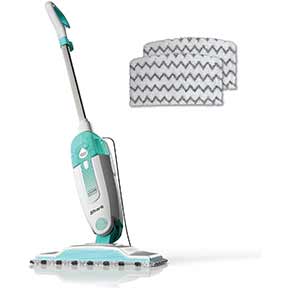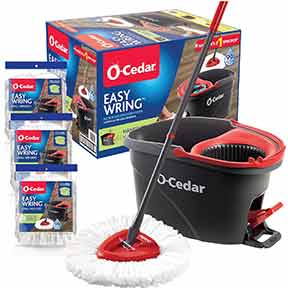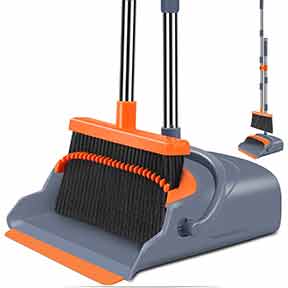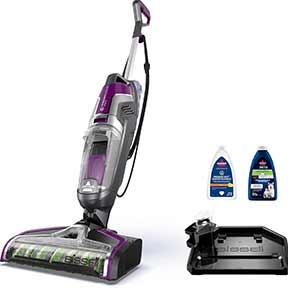How to Clean Linoleum Floors
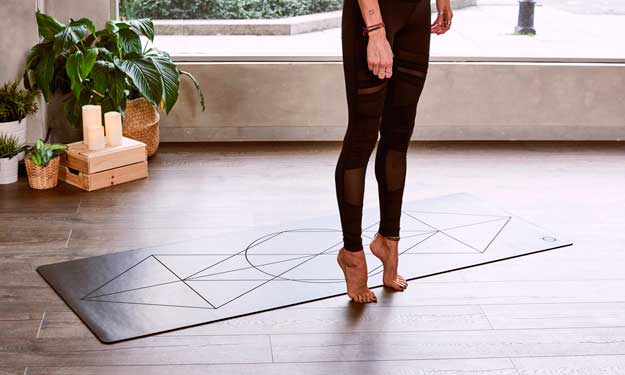
Sweeping, Mopping Cleaning and Maintaining Linoleum Floors.
Linoleum Floor Care and Cleaning Tips
One of the nice things about linoleum is that it’s extremely durable. In fact, it’s so durable; it’s been used as interior floor covering on battleships because it holds up. Linoleum has been a flooring option for over 100 years and still a desirable choice today because it can last decades so it’s good to know how to clean linoleum floors! Linoleum is made from renewable materials such as: linseed oil, wood and cork dust, along with several minerals and other compounds used for the backing. It’s hypoallergenic, which makes it a great floor covering choice for people with severe allergies. Caring for a linoleum floor involves the usual cleaning tools: A broom, a dust pan, a mop, vinegar, warm water and a bucket.General Cleaning: Linoleum Floors
If possible, dust mop daily to remove any dirt, a microfiber mop works great. This is one of the first steps in linoleum floor care. If daily cleaning is not possible, a weekly cleaning is recommended. Just sweep (with a soft bristled brush) or vacuum to pick up any dirt and debris before mopping. Linoleum doesn’t scratch as easily as other floor coverings, but it will scratch if treated poorly.Mopping Linoleum Floors
Once you’ve swept and cleaned the floor of dirt and debris, it’s time to move on to mopping. We use a machine washable microfiber floor mop. The mop is reusable and is tossed in the washing machine along with our cleaning towels. It needs to air dry so don’t toss it in the dryer after washing. For optimal mopping, use a minimum amount of water. Do not flood the floor with water. The idea isn’t to slosh a bunch of water on the floor. Think of the mop as a damp dishtowel that you use to wipe off counters. Contrary to popular belief, you don’t need (and shouldn’t use) soap to mop the floors. Soap leaves a residue that can leave floors sticky and spotty. We use vinegar at our cleaning company- not because it’s cheap, but because it’s the best thing to use, period. Plain white vinegar will cut through grease and grime better than any commercial cleaner. Plus, it’s non-toxic and a natural deodorizer.The Cleaning Process
- Fill a large bucket with warm water. Use about 2 gallons water to 1 cups white vinegar.
- Dip the mop in the bucket and wring well. Remember, you only need a damp mop.
- Completely go over the floor with the mop.
- Rinse the mop in the bucket after each pass across the floor. This way you are not just pushing dirty water across the floor.
- If your floors are really dirty, empty the bucket and refill with clean water and more vinegar as needed.
Drying Linoleum Floors
Dry the floor after mopping. Yes, dry it. Drying the floor stops water spots from forming. The water spots form because of minerals that are naturally present in the water remain on the linoleum after the water evaporates. Linoleum really doesn’t like water being left on it. (No floors do) The floor will last longer if you do not leave water on it. You can use a towel and dry it on your hands and knees, or stand on a clean towel and shuffle your feet around the floor. We use a Sh-mop to dry the floor. It’s basically a terrycloth towel at the end of a handle that you can use to dry the floor quickly. The terry cloth comes off the base and you run it through the washer and dryer. We use it only to dry the floor, but you can use a sh-mop to both mop AND dry the floor. As long as you have enough of the terry cloth towels to put on the sh-mop you’re good to go!Heavy Duty Linoleum Floor Cleaning
Some linoleum floors have patterns where dirt and grime can accumulate. If the etched detail in your linoleum is looking a little grungy, you may need to get down on your hands and knees with a toothbrush, soft nylon brush or grout brush to scrub. Just don’t use anything sharp and a gentle scrubbing will work just fine. Start with a clean bucket of water and vinegar (recipe above) and dip the brush into it. Scrub the detailed areas until the dirt is loosened and then wipe with a clean rag. Caring for your linoleum floor will be much more rewarding if you keep the entire floor clean and bright.Polishing Linoleum Floors
As long as the floor has been well cared for, floor polish isn’t really necessary. But if so desired, polish can be added for extra protection. There are many commercial floor polishes on the market. See what the manufacturer suggests.Linoleum Floor Care Tips
Use furniture pads under chairs to avoid scratches and don’t let water stand on floor as it will damage the floor. Do not use ammonia on the floor as it can strip the polish. To keep the floors looking nice all the time, keep doormats or rugs in entryways to avoid scratches from dirt on shoes. Do not use a rubber backed rug as this can stain the floor.Removing Scuff Marks from Linoleum Flooring
Even though linoleum can withstand high amounts of foot traffic, scuff marks do happen. There are a few options to remove scuff marks easily. Whichever option you use, be sure to clean, rinse and dry the floor when done.- A clean pencil eraser can help remove scuff marks.
- Clean Magic Eraser. Keep wet and lightly clean. No need to rub hard.
- Rub a light coat of baby oil or WD-40 on the stain.
Floor Supplies
